Text
The mind makes and makes, spinning its web.
Sylvia Plath, The Unabridged Journals of Sylvia Plath — 17th July 1957
1K notes
·
View notes
Text
I think that more fanfiction should be written with the aim to tackle the original meaning of hanahaki. Because when the concept of hanahaki disease was originally created, it was intended to be a metaphor for suppressing one’s feelings.
Your feelings are this beautiful garden of flora inside of your chest. When you express how you feel honestly, you allow for it to grow freely. But when you hide how you feel out of fear of rejection, and try to make it smaller and smaller, the flowers become cramped inside of you, until you choke on your own feelings. Every flower you cough up is something you’ve felt, but refused to say.
The whole “dying” thing is intended to be more symbolic especially. You’re killing off bits and pieces of yourself and how you feel, because you’re afraid to express yourself.
It’s not really supposed to be, “The one I love doesn’t love me back, and I’m dying from it.” Rather, it’s more along the lines of, “Repressing your emotions is bad for you, and it’s better and healthier to express them freely, even when it’s scary.”
Which is to say that, one, the cure for the disease should be telling the person that you are in love with how you feel. How the other person feels about the person afflicted should have nothing to do with it, as the trope is meant to be about feeling your emotions unapologetically.
And that, two, it’s not an inherently romantic trope. Obviously, it has romantic applications, but it can be written for any situation where a character is hiding how they truly feel. This can include a refusal to address a specific trauma, a desire to indulge in something that they’re ashamed of, and even really practical things, like wanting to ask one’s boss for a higher position.
Although (as an aromantic person myself) I don’t agree with this conclusion about the trope, this application would also avoid people calling it arophobic. When the thing killing the character is a refusal to be honest with themselves, rather than an unrequited love, it’s on nobody’s hands but their own to save their life.
There are a ton of ways that this interpretation of the hanahaki disease could be applied in new and interesting ways in fanfiction, and I’d love to read what things people could come up with!
23K notes
·
View notes
Text
July Prompts 🌴
Word prompts to use for doodling or writing
summer kiss
cocktail
pineapple
vacation
camera
message in a bottle
lemonade stand
summer dress
beach
road trip
football game
airy
lifeguard
childhood
ice tea
sun screen
treasure hunt
pool party
fireflies
concert
succulents
pink skies
underwater
bubbles
flower field
hurricane
cherries
dancing in the rain
sun burn
rooftop
camping
3K notes
·
View notes
Note
How do I describe a character when they’re angry and just “so done”? How would they act?
A Quick Guide to Writing Anger
It’s the hot-blooded, ever-challenging, angry character that often steals a scene and captivates readers’ hearts. From the brooding protagonist to the volatile villain, anger introduces a heightened element of emotive dynamism. Anger is a powerful emotion that can define a character's behaviour, interactions, body language, and attitude.
How Do They Behave?
Make impulsive decisions
Have a short fuse and react explosively
Hold grudges
Be physically aggressive
Be motivated by revenge
Exhibit self-destructive tendencies
Speak at an increased volume
Speak unexpectedly fast or slow
How Do They Interact?
Have issues with authority
Struggle to follow orders or instructions
Confrontational or verbally abusive
Overuse of swear words or insults
Struggle to focus or listen to others
Dominate conversations and interrupt often
Become isolationist
Short-tempered and accusatory
Describe Their Body Language
Clenched fists and tight jaw
Rigid and defensive posture
Maintained eye contact
Pacing or fidgeting
Aggressive movements
Increased muscle tension
Point and jab when speaking
Invade others’ personal space
Describe Their Attitude
A sense of dissatisfaction and frustration
Overly sceptical and distrustful of others
Impatient and easily annoyed
Confrontational and arrogant
Feelings of powerlessness
Motivated by vengeance or justice
Hostile and irritable
Blunt, direct, and stubborn
A lack of empathy
Positive Outcomes
Be a motivator for change
Inspire others with their passion for justice
Can be a motivator for personal growth
Learn to articulate their needs and set boundaries
Develop resilience and strength by managing their anger
Increased assertiveness
Experience catharsis and emotional release
Improved problem-solving skills
Negative Outcomes
Damaging to their relationship with others
Can lead to chronic stress or health issues
Become isolated, leading to loneliness and depression
Develop a reputation for being difficult or aggressive
Can cause legal troubles or social rejection
Lower self-esteem and sense of self-worth
Become violent or cause physical harm
Exhibit impaired judgement or decision-making
Useful synonyms
Furious
Enraged
Wrathful
Incensed
Infuriated
Livid
Raging
Fuming
Irate
Outraged
Vexed
Irritated
Resentful
Indignant
Seething
Mad
Hostile
Incensed
Cross
Huffy
2K notes
·
View notes
Text
internet search tips on how i sift through junk or mischaracterizing content when looking up visual animal references:
Use the scientific name instead of common name for less false ID (especially if you want to see real wolverines or jaguars instead of the x-men or car maker)
Instead of “baby“, try “juvenile” or a more species specific term (bird=chick, bovid=calf, carnivoran=cub, etc..)
If it’s a rarer animal without many results try searching its name in a native language, it’s usually on wikipedia
Search the scientific name in inaturalist for multiple party verified ID sightings with locations
Searching “skeletal” in place of “skeleton” gives different results and usually less products

try adding “zoo” to your search if you want to look at over-exploited viral species like otters, foxes, primates, or exotic cats. there can still be shady zoos but it weeds out videos of animals in people’s living rooms
Add “vet” if you’re searching for reference on how large/small an animal looks next to a human instead of exotic pet vids. vets and zoos can be very fond of sharing educational pics of an anesthetized animal’s cool features or a huge paw/teeth besides a human hand. vet visits for beloved zoo animals also tend to draw the media so there’s many articles written for them and in general i just love learning about weird vet procedures on exotic animals, 10/10 rabbit hole.
“Morph” or “mutation” tends to give you more legit resources on animal variations instead of photoshop edits.
Even though i know there’s a difference I also find that searching “leucistic” just gives you less fake stuff than the more commonly known albino or “white___” unless its a very common mutation. same with “dilute” instead of blue and such.
7K notes
·
View notes
Text
How to use the five act structure
Here’s a quick breakdown of the 5-act structure!
3 act structure is all the rage, but do you know much about the 5 act structure, how or when you should use it?
The five-act structure is often used for stories that have a more complex narrative and multiple subplots. It’s usually centred around the middle twist of your story and divided into the world before the event, and the world after it.
The types of stories this suits well:
📌epic fantasy or sci-fi
📌historical & periods dramas
📌character-driven literary pieces
👉 Act 1 - Exposition
As with every story structure, act 1 is all about setting up the world of your protagonist. You want to introduce us to their struggles, their current world, and propel us into the story by introducing the inciting incident.
👉 Act 2 - Rising action
After the inciting incident, your character develops a goal and should now begin to make active decisions to chase it. Act 2 is all about the build-up to the biggest moment in the story.
👉 Act 3 - Climax
This is the turning point we’ve been building up to, and the protagonist is just within reach of their goal, but something happens that completely throws them off their path.
👉 Act 4 - Falling action
Act 4 mirrors act 1, where the character readjusts to their new world based on what happened in the climax, but they now need yet another inciting incident or turning point to get them back on track. Usually they’ll being to go through their transformation at the end of act 4!
👉 Act 5 - Resolution
Act 5 is your big finale, where the protagonist finally faces that one last challenge, with their perspective or their priorities changed.
📖 My e-book “Plotter’s Almanac” breaks down the 5 act structure in more detail, but you also get the breakdowns of the 3-act structure, and the Save the Cat structure, plus templates to create your outline!
It’s in my pack of 3 essential e-books for writers! They each come with 40 pages of easy theory and resources, and cute fully customisable templates for your project.
- The Plotter’s Almanac
- The Character Bible
- The World Builder’s Chronicle
Grab it through the [link here] or below!
120 notes
·
View notes
Link
Independent bookstores around the country have a particularly clever lifeline, one perfectly suited to the unprecedented moment we find ourselves in. The strange part? It came into being just weeks before the World Health Organization declared the coronavirus outbreak a pandemic, and before the bookstores started closing up shop wondering if they’d reopen at all.
The lifeline in question is called Bookshop.
In simple terms, it’s a super clean, user-friendly online bookstore whose raison d’être is supporting independent bookstores — not simply with exposure or resources (though that’s certainly a factor), but with cold hard cash…
55K notes
·
View notes
Text
i had three fic ideas. wrote one. i still have three fic ideas. this is not how math is supposed to work.
146K notes
·
View notes
Text
Different Ways to Describe Green Eyes
-> feel free to edit and adjust pronouns as you see fit.
He had eyes like the fields after a sweet summer rain.
Their eyes reminded her of the forests at night.
Her green eyes were like leaves with golden sunlight shining filtering through them.
Green eyes— usually a symbol of grace— had never held such a look of hatred.
She had eyes the same color as the bottle of poison tucked away safely in the inside pocket of her jacket.
He stared deep into her green eyes and saw forever reflected in them.
Their eyes were the same color as the moldy piece of bread he found under the couch a couple days ago.
She bit into the apple— the same color as her sour green eyes— and flashed him a wicked grin.
He stared at the green walls of his childhood bedroom, but it only made him think of [Name’s] eyes that always teased him.
Their eyes reeked of danger, the color of acid and a threat.
Her eyes were the color of the woods at twilight.
His green eyes kept a lifetime of secrets locked away behind them.
Their eyes reminded him of a cat’s: mischievous and quick to chase.
She had eyes like spring and the memory of a childhood summer.
His eyes matched the emerald ring he wore on his finger.
They had heard the saying “the grass is greener on the other side” their entire life, but after seeing her eyes? They finally thought it might have some truth to it.
Her eyes made him think of germs. It wasn’t the most colorful of metaphors, but he thought it went well with the way it made him feel. Sick.
His eyes were as green as the potions that lined the shelves in their glass bottles.
2K notes
·
View notes
Note
is a passive character always bad or is it fine if a character is passive as far as they aren't the main character?
Passive Personality vs Passive Character
Passive personality is when a character is easygoing, low key, and sometimes shy. They usually try to avoid confrontation and "making waves," which means they tend to go with the flow and sometimes let their own wishes and needs fall behind the wishes and needs of those around them. Since this is a real world personality type, it's fine to have a character with a passive personality. Even passive people can have an active role in moving the story forward, they're just not as proactive and aggressive in the ways they do that.
Passive characters are characters who have little to no active role in moving the story forward. This is fine for background characters who are only there to fill out the story's world, though most stories don't need a lot of characters like this. Main characters, and most minor characters, need to play some role in moving the story forward, even if it's a very small role. For example, if your character befriends one of the prison guards and you go as far as giving this character a name, dialogue, and a few background details, if they don't say or do something that directly or indirectly moves the story forward, they're a passive character, and generally you want to avoid that. Protagonists and main characters should never be passive, because if they don't say or do things that move the story forward, there's no reason for them to be there.
Have fun with your story!
•••••••••••••••••••••••••••••••••
I’ve been writing seriously for over 30 years and love to share what I’ve learned. Have a writing question? My inbox is always open!
Learn more about WQA
Visit my Master List of Top Posts
Go to ko-fi.com/wqa to buy me coffee or see my commissions
96 notes
·
View notes
Text
Why most writers fail
Trying to throw some gritty inspiration at you guys today! Have an inward look and think about what writing really means to you, and whether you enjoy writing or having written, because the difference might seem subtle, but I believe is a very important distinction to make.
Here’s why 97% of writers never finish their books.
Almost every other person has once had an inkling to write a book, and so many have started writing, only to give up a few pages in. Why?
This can happen for a lot of reasons, and if you haven’t finished your book yet, you might find yourself in one of these reasons:
📌 You’ve never finished a short-form story before.
📌 You’re not familiar with story structures or you go straight in without planning.
📌 You expect it to be perfect on first go.
📌 You have a serious fear of failure.
📌 You’re not dedicated enough or you lose your passion and interest.
📌 You’re bad at taking feedback.
📌 You keep restarting.
And these reasons are all valid - But the real truth of it all?
Writing a book is mighty difficult.
It’s a long-process, and one that’s not instantly-gratifying. Humans love instant gratification - and when they find writing won’t give them that, they give up.
The fact of the matter is: writing is not a hobby driven by gratification, but rather by perseverance, hard work, and a lot of thinking and rethinking.
It’s likely that even with a finished book, you’ll still feel you could have done better.
But that’s also the beauty of it. Writing is not made to be a seeking of gratification, but rather an attempt to understand more about ourselves and our world.
Do you need a little motivation to get started? Pick up my free novel plan through the [link here] or below!
94 notes
·
View notes
Text
A general cane guide for writers and artists (from a cane user, writer, and artist!)
Disclaimer: Though I have been using a cane for 6 years, I am not a doctor, nor am I by any means an expert. This guide is true to my experience, but there are as many ways to use a cane as there are cane users!
This guide will not include: White canes for blindness, crutches, walkers, or wheelchairs as I have no personal experience with these.
This is meant to be a general guide to get you started and avoid some common mishaps/misconceptions in your writing, but you absolutely should continue to do your own research outside of this guide!
This is NOT a medical resource!!! And never tell a real person you think they're using a cane wrong!

The biggest recurring problem I've seen is using the cane on the wrong side. The cane goes on the opposite side of the pain! If your character has even-sided pain or needs it for balance/weakness, then use the cane in the non-dominant hand to keep the dominant hand free. Some cane users also switch sides to give their arm a rest!
A cane takes about 20% of your weight off the opposite leg. It should fit within your natural gait and become something of an extension of your body. If you need more weight off than 20%, then crutches, a walker, or a wheelchair is needed.
Putting more pressure on the cane, using it on the wrong side, or having it at the wrong height can make it less effective, and can cause long term damage to your body from improper pressure and posture. (Hugh Laurie genuinely hurt his body from years of using a cane wrong on House!)
(some people elect to use a cane wrong for their personal situation despite this, everyone is different!)
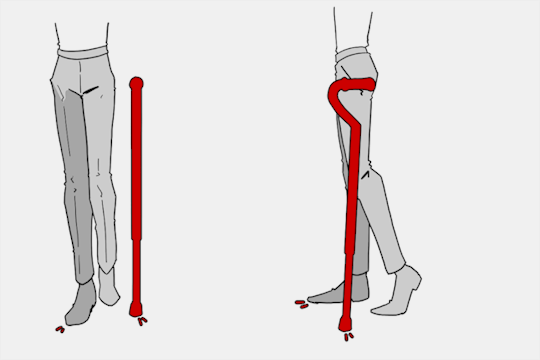
(an animated GIF of a cane matching the natural walking gait. It turns red when pressure is placed on it.)
When going up and down stairs, there is an ideal standard: You want to use the handrail and the cane at the same time, or prioritize the handrail if it's only on one side. When going up stairs you lead with your good leg and follow with the cane and hurt leg together. When going down stairs you lead with the cane and the bad leg and follow with the good leg!
Realistically though, many people don't move out of the way for cane users to access the railing, many stairs don't have railings, and many are wet, rusty, or generally not ideal to grip.
In these cases, if you have a friend nearby, holding on to them is a good idea. Or, take it one step at a time carefully if you're alone.
Now we come to a very common mistake I see... Using fashion canes for medical use!
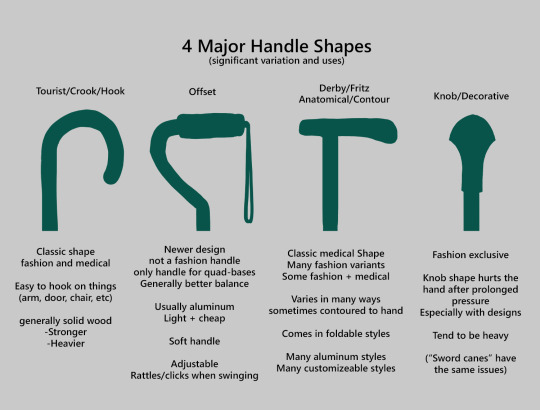
(These are 4 broad shapes, but there is INCREDIBLE variation in cane handles. Research heavily what will be best for your character's specific needs!)
The handle is the contact point for all the weight you're putting on your cane, and that pressure is being put onto your hand, wrist, and shoulder. So the shape is very important for long term use!
Knob handles (and very decorative handles) are not used for medical use for this reason. It adds extra stress to the body and can damage your hand to put constant pressure onto these painful shapes.
The weight of a cane is also incredibly important, as a heavier cane will cause wear on your body much faster. When you're using it all day, it gets heavy fast! If your character struggles with weakness, then they won't want a heavy cane if they can help it!
This is also part of why sword canes aren't usually very viable for medical use (along with them usually being knob handles) is that swords are extra weight!
However, a small knife or perhaps a retractable blade hidden within the base might be viable even for weak characters.
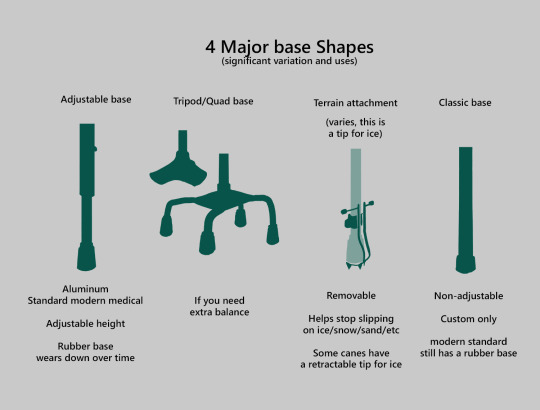
Bases have a lot of variability as well, and the modern standard is generally adjustable bases. Adjustable canes are very handy if your character regularly changes shoe height, for instance (gotta keep the height at your hip!)
Canes help on most terrain with their standard base and structure. But for some terrain, you might want a different base, or to forego the cane entirely! This article covers it pretty well.
Many cane users decorate their canes! Stickers are incredibly common, and painting canes is relatively common as well! You'll also see people replacing the standard wrist strap with a personalized one, or even adding a small charm to the ring the strap connects to. (nothing too large, or it gets annoying as the cane is swinging around everywhere)
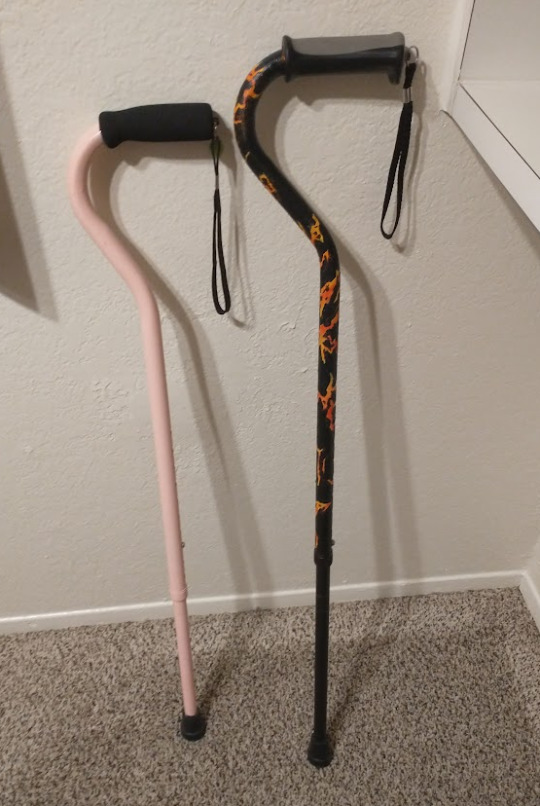
(my canes, for reference)
If your character uses a cane full time, then they might also have multiple canes that look different aesthetically to match their outfits!
When it comes to practical things outside of the cane, you reasonably only have one hand available while it's being used. Many people will hook their cane onto their arm or let it dangle on the strap (if they have one) while using their cane arm, but it's often significantly less convenient than 2 hands. But, if you need 2 hands, then it's either setting the cane down or letting it hang!
For this reason, optimizing one handed use is ideal! Keeping bags/items on the side of your free hand helps keep your items accessible.

When sitting, the cane either leans against a wall or table, goes under the chair, or hooks onto the back of the chair. (It often falls when hanging off of a chair, in my experience)
When getting up, the user will either use their cane to help them balance/support as they stand, or get up and then grab their cane. This depends on what it's being used for (balance vs pain when walking, for instance!)
That's everything I can think of for now. Thank you for reading my long-but-absolutely-not-comprehensive list of things to keep in mind when writing or drawing a cane user!
Happy disability pride month! Go forth and make more characters use canes!!!
73K notes
·
View notes
Text
What is...
On every What is Wednesdays I will explain a trope, a rhetorical device, or a literary technique in a few sentences. Put in the comments what you would like me to explain next.
What is... a drabble?
What is... dead dove?
What is... archetypal characters?
What is… deus ex machina?
What is… whump?
What is... plot bunny?
What is... canon vs. fanon?
What is… a headcanon?
What is… a plot hole?
What is… retcon?
What is… WIP?
What is… a sequel hook?
What is… a crossover?
What is… crack?
What is… a rarepair?
What is… a red herring?
What is… fluff?
What is… smut?
What is… OOC?
What is… a missing scene?
What is… Coda?
What is… a trope?
What is… Alpha vs. Beta Reader?
What is… a cliffhanger?
If you like my blog and want to support me, you can buy me a coffee or become a member! And check out my Instagram! 🥰
11K notes
·
View notes
Text
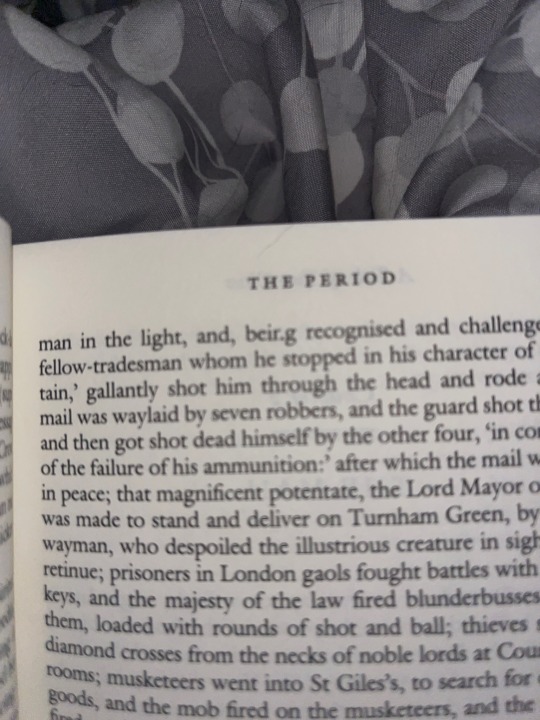
I FOUND A TYPO IN CHARLES DICKENS’S THE TALE OF THE TWO CITIES!
Proof to writers that even the classics make mistakes.
And yes, I found this at precisely 2:50 in the morning.
14 notes
·
View notes
Text
Symbolic trees for writers
Here are some tree symbolisms that you might be able to use in your novel! Have you ever thought about using trees and plants as omens or symbols in your story?
🌳 Willow
A “Weeping willow” can often be used as backdrop for scenes of grief, but it also symbolises strength and perseverance through difficult times.
🌳 Redwood
Often referred to as the “Tree of life” as it can grow to over a thousand years long, it symbolises longevity. In spirituality and magic, it’s believed to have healing properties, both physically and mentally.
🌳 Oak
Oak trees are seen as sturdy symbols of power and authority, often identified with strength and endurance. It represents safety and support.
🌳 Birch
Birches are identified with birth and renewal, they symbolise new beginnings and starting over.
🌳 Elm
Elms signify the underworld and death. They can drop dead branches without warning. Elm wood was also the preferred choice for coffins.
🌳 Pine
Pines are evergreen trees that never lose their leaves, so they symbolise immortality and eternal life.
🌳 Maple
Maple trees symbolise abundance and success. In the spiritual realm, the maple branches are believed to have been used by witches to acquire more power.
🌳 Elder tree
Elder trees are said to protect against enchantment, negativity, and the presence of the Devil. Burning it would bring trouble your way.
Want a more organised approach to your writing?
Pick up my 3 extensive workbooks for writers through the [link here] or below, with dozens of fully-customisable templates.
178 notes
·
View notes
